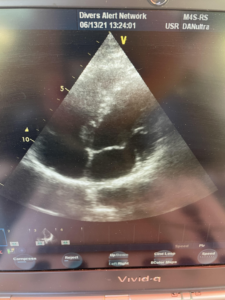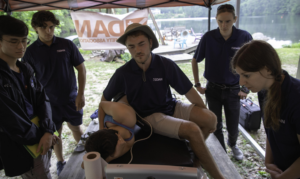My time here at Divers Alert Network started with meeting and learning about the different departments including research, medical, marketing, and operations. We spent a few days taking a research field operator workshop, learning how to operate the various devices we use in data collection. The other interns and I then got briefed on the projects we would be working on over the summer and began doing literature review on them.
One project we started for the summer includes a neurocognitive battery test designed to measure mental fatigue in divers. This test involves a series of 10 “brain” games designed to test working memory, reaction time, dexterity, etc. Another project involves assessing the hydration status of divers by collecting urine samples pre- and post-dive and measuring markers such as specific gravity and osmolality.
Some of DAN’s ongoing projects that we jumped in on include an ultrasound comparison study where we take ultrasounds of divers with three devices to see if they all give comparable results. One is a larger ultrasound device with a computer, one a smaller ultrasound device that can hook up to an iPad or iPhone, and one a small doppler device that records sounds. Another project we jumped in on is the cardiac study where ECG leads are hooked up to divers to measure the electrical activity of their heart before, during, and after a dive.

We decided to clean out the DAN library as we try to make all of the diving-related literature virtually accessible.

This is a picture from our field operator workshop when David Le from UNC came to talk to us about the physics of ultrasound and how we can use it to manipulate microbubbles.

Here is a picture of my heart under the Vivid q ultrasound computer after a dive. We were able to see small venous gas emboli flowing through the right side of my heart. These bubbles are produced when inert gas comes out of solution during a high to low pressure change and can get lodged in the body and produce symptoms of decompression sickness. Most of the time they are benign. These gas bubbles are the reason divers do safety stops at shallow depths so they can decompress.

This picture is from our first ultrasound comparison weekend at Mystery Lake in NC (credit Dr. David Charash).
We have also done some fun dives at quarries around the area including Fantasy Lake and Blue Stone Quarry.

Over Memorial Day Weekend, we found an old American flag during a dive under a bunch of silt and thought it was only right to haul it back to the surface.
We have gotten to tour two hyperbaric chambers so far where divers become patients when they are struck with decompression illnesses. These chambers are used to treat a variety of other diseases and conditions, too. During the Undersea and Hyperbaric Medical Society annual conference, we learned about how these chambers operate and recompress divers to various depths and on various gas mixes.

Duke University’s hyperbaric chambers. There are 7 chambers here that house patients, hyperbaric technicians, and research participants.

Smaller chamber at Bluestone Quarry.

